Genre: Platformer Developer: Game Freak Publisher: Sega of Japan Players: 1 Released: 1992
It’s been more than a few years since I’ve really been into anime, and the overwhelming amount of TV series that have slowly overtaken the scene keeps me watching movies and miniseries from the ’70s-’90s. I don’t have the time (or cash) to buy forty volumes of Hyakumundai Katzsu-Kalinske Segamachu, or whatever the latest hit out of Japan is, so you can imagine what it’s like to play games based on them. Half of the time spent watching them has me trying to figure out who’s who and what’s going on.
Now take that confusion and rewind back to the early ’90s and a colorful platforming game called Magical Taruruuto-Kun. The manual is of no help to me, and the Internet is more than a decade beyond my reach. From what little I can gather, it seems the game centers around a little wizard-like character who must go through several stages of platforming action to… um, he’s supposed to…
Ok, I don’t know what the hell he’s supposed to be doing. I just shrug my shoulders and play the darn thing. It wasn’t until years later that I discovered that it’s based on a manga and cartoon about a fifth grader named Edojou Honmaru who gets beat up all the time. He calls Taruruuto from the world of magic to help him, but his new friend isn’t much of a wizard. Much hilarity ensues as Edojou moves to the top of the class. If you’re a fan of the series, then you’ll recognize all the characters and funny lines of dialogue (ok, scratch that last part…). The other 99% of us will concentrate on the platforming.
Thankfully, this is one area where no knowledge of Japanese is required. I’d even go so far as to say that no real knowledge of platforming is required either. Magical Taruruuto-Kun is about as straight forward as they come, and there are very few parts that require any real skill. The most valuable asset one can have playing is probably going to be patience, as little Taruruuto suffers from Moon Jump Syndrome, and every leap is like Michael Jordan from the free throw line. It’s quite easy to overshoot a platform and fall to your death. Most stages don’t throw anything particularly hard, but some can be needlessly frustrating. Stage three’s auto-scrolling cloud level instantly comes to mind. Having to restart the whole level from the beginning after you die is another example of the stale trial-and-error gameplay that bogged down so many platformers of the era.
I’d say that a bigger offender than the spotty control has to be the level design. For a game released in 1992, one would expect it to feature more than the tired “move right with the occasional jump” that was so common the NES and Master System. This is post-Sonic and Mario World people, where’s the innovation? Why are the platforms placed in a way that offers no challenge at all to navigate, and why are the enemies almost scared to attack me? Aside from a shield-bearing troll on the bridge now and then, there wasn’t anything else that even remotely posed a threat. This goes double for bosses too. Only one (the minatour-type pictured left) was interesting, and even he went down much too easily. Someone needs to put a picture of Magical Taruruuto-Kun under “going through the motions” in Wikipedia.
Bandai tried to spice things up by adding magic to the mix, but it feels tacked-on and isn’t really needed most of the time. Taruruuto’s primary means of attack is to smack enemies with his wand, but he can also touch objects and bring them to life for use as a projectile weapon. “Life” consists of little more than a facial expression on said object, but who can deny the fun of slinging a pissed off fire extinguisher at someone? Breaking chests which are strategically placed yields power ups like extra health, more magic attacks (you can only use them once each), and even a 1up. That’s as far as it goes though, and it’s often easier to just Moon Jump over an enemy than take the time to whack it with your wand.
Taruruuto also has the benefit of magic, though I’m not sure how much of an actual benefit it is. From the second stage on, he can activate short – and I mean short – bouts of invincibility. Later, he also acquires the ability to call a friendly witch to eliminate onscreen baddies. Almost totally useless during regular stages, magic does have its uses against boss battles. Not because they’re particularly hard, but because you’ll have to do the whole tedious event over if you die. It’s best to stockpile them during the game and just let go on the boss.
About the only move Taruruuto has that’s of any worth is his glide ability. Most of the stages are designed with its use in mind, and you’ll have to run down slopes to gain speed, jump off high platforms to glide over gaps, and even glide through openings too small to walk through. The control is as loose here as it is jumping, however, and it can put a damper on trying to turn if you should overshoot a platform. Furthermore, it doesn’t seem like the developers really took its potential use into account, and this breaks certain areas of the gameplay. On some stages, for example, it’s even possible to just hop off a ledge on the top of the screen and just glide all the way to the end of the stage.
While the saccharine-sweet theme of the game (everything is so darn cute!) can’t manage to overcome the simplistic gameplay, it isn’t for lack of effort. The whole game just seems want to make you say “awwww,” and it almost works. Smiling clouds, small and inoffensive enemies, and Taruruuto’s candy-coated voice overs are literally everywhere. The visuals are excellent – a lot better than the tinny audio – and bear more than a passing resemblance to those of Monster World IV and Pulseman in palette choice and style (I’m not surprised by the similarity to the latter, which is a Game Freak title as well), but the enemies are repetitive and not very imaginative in design. How many of those little punk dudes am I going to have to face?
In the end, I guess you really can’t expect all that much from a game that is basically import licensed fodder. The subject matter, while lost on most western gamers (do you remember the anime series from 1988-1992? Me neither), won’t interfere in the actual gameplay. Not that it needs to, as the gameplay is its own worst enemy here. Simple and uninspired, jumping from one predictably-placed platform to another gets old quickly, and the useless attacks do nothing to spur an interest in playing on. These factors, combined with the repetitive soundtrack and the lack of mid-level checkpoints, warp this one to the dimension of Games Left to Rot on the Shelf. Do yourself a favor and point your magic wand at another game, unless it’s set to “disintegrate.”
SCORE: 4 out of 10

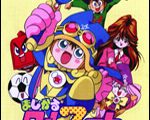
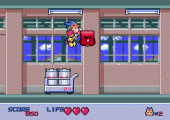
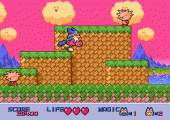
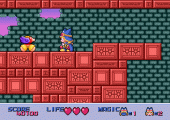
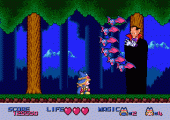
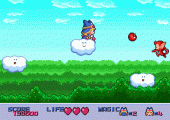
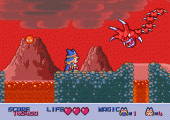
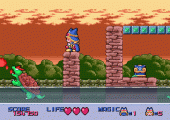
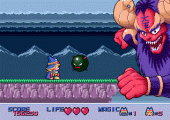
Recent Comments